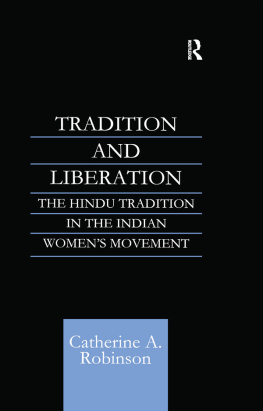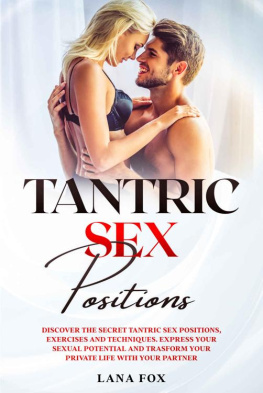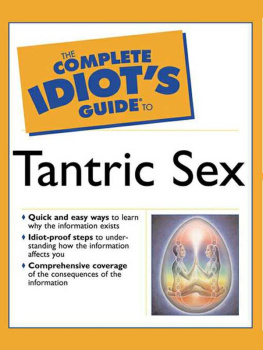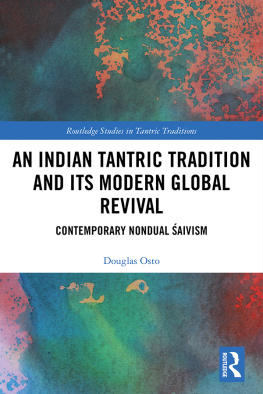Gavin Flood - The Tantric Body: The Secret Tradition of Hindu Religion
Here you can read online Gavin Flood - The Tantric Body: The Secret Tradition of Hindu Religion full text of the book (entire story) in english for free. Download pdf and epub, get meaning, cover and reviews about this ebook. year: 2005, publisher: I. B. Tauris, genre: Religion. Description of the work, (preface) as well as reviews are available. Best literature library LitArk.com created for fans of good reading and offers a wide selection of genres:
Romance novel
Science fiction
Adventure
Detective
Science
History
Home and family
Prose
Art
Politics
Computer
Non-fiction
Religion
Business
Children
Humor
Choose a favorite category and find really read worthwhile books. Enjoy immersion in the world of imagination, feel the emotions of the characters or learn something new for yourself, make an fascinating discovery.

- Book:The Tantric Body: The Secret Tradition of Hindu Religion
- Author:
- Publisher:I. B. Tauris
- Genre:
- Year:2005
- Rating:5 / 5
- Favourites:Add to favourites
- Your mark:
- 100
- 1
- 2
- 3
- 4
- 5
The Tantric Body: The Secret Tradition of Hindu Religion: summary, description and annotation
We offer to read an annotation, description, summary or preface (depends on what the author of the book "The Tantric Body: The Secret Tradition of Hindu Religion" wrote himself). If you haven't found the necessary information about the book — write in the comments, we will try to find it.
Gavin Flood: author's other books
Who wrote The Tantric Body: The Secret Tradition of Hindu Religion? Find out the surname, the name of the author of the book and a list of all author's works by series.
The Tantric Body: The Secret Tradition of Hindu Religion — read online for free the complete book (whole text) full work
Below is the text of the book, divided by pages. System saving the place of the last page read, allows you to conveniently read the book "The Tantric Body: The Secret Tradition of Hindu Religion" online for free, without having to search again every time where you left off. Put a bookmark, and you can go to the page where you finished reading at any time.
Font size:
Interval:
Bookmark:

T antra ('woven together' in Sanskrit) is the Hindu-based religion which originated i ,200 years ago, when the great erotic temples were built. In the West it is now best known for the inspiration of tantric yoga, and its associated ritualistic forms of sex. But is Tantra just about esoteric sexual practice or does it amount to something more? This lively and original book contributes to a more complete understanding of Tantra's mysteries by discussing the idea of the body in Hindu tantric thought and practice in India.
The author argues that within Tantra the body is a vehicle for the spirituality that is fundamental to people's lives. The tantric body cannot be understood outside the traditions and texts that give it form. Through practice (ritual, yoga and 'reading') the body is formed into a pattern determined by tradition, and the practitioner thereby moulds his or her life into the shape of the tradition. While there is a great range of tantric bodies - from ascetics living in cremation grounds, to low-caste people possessed by tantric deities, to sophisticated high-caste Brahmans expounding the ascetic philosophy of Tantra - all share certain common assumptions and processes. Flood argues that while there is a divergence at different social levels and in different levels of tantric metaphysical claims, these levels are united by a process which the author calls 'entextualisation of the body'. The body becomes the text through the tradition being inscribed on it. This general claim is tested against specific ritual and doctrinal examples, and the tantric traditions are linked to wider social and political forces.
The Tantric Body is a fascinating study that makes an important contribution to the study of South Asian religion, and will have strong appeal to students of South Asian societies and cultures as well as to those of comparative philosophy.
Gavin Flood is Professor of Religion at the University of Stirling and Academic Director of the Oxford Centre for Hindu Studies. He is the author of An Introduction to Hinduism (1996) and general editor of The Blackwell Companion to Hinduism (2003).

The Tantric Body
The Secret Tradition of Hindu Religion
GAVIN FLOOD
I.B.TAURIS
LONDON NEW YORK
Published in 2006 by
LB. Tauris & Co. Ltd
6 Salem Rd, London W2 4BU
175 Fifth Avenue, New York NY 10010
www.ibtauris.com
In the United States and Canada distributed by Palgrave Macmillan, a division of St. Martin's Press, 175 Fifth Avenue, New York, NY 10010
Copyright Gavin Flood 2006
The right of Gavin Flood to be identified as the author of this work
has been asserted by him in accordance with the Copyright, Designs
and Patents Act, 1988
Frontispiece: Cakra man (Wellcome Ms P511). With kind permission of the Wellcome Trust.
All rights reserved. Except for brief quotations in a review, this book, or
any part thereof, may not be reproduced, stored in or introduced into a
retrieval system, or transmitted, in any form or by any means, electronic,
mechanical, photocopying, recording or otherwise, without the prior
written permission of the publisher.
ISBN 1 84511 on o (Hb) ISBN 1 84511 012 9 (Pb) ean 978 i 84511 on 6 (Hb)
EAN 978 I 8451 I 012 3 (Pb)
A full CIP record for this book is available from the British Library
A full CIP record for this book is available from the Library of Congress
Library of Congress catalog card: available
Typeset in Monotype Ehrhardt by illuminati, Grosmont,
www.illuminatibooks.co.uk
Printed and bound in Great Britain by TJ. International Ltd,
Padstow, Cornwall
Contents
Preface ix
PART I Theory, Text and History
i Introduction: The Body as Text 3
Tantra, Tradition and the Body 7 Reading Strategies: Text 15 Reading Strategies: Body 20 Experience and Asceticism 24 The Argument of the Book 27
2 The Vedic Body 31
The Political and Social Context 32 Legal Discourse 37 Political Discourse 42 The Highest Good 45
3 The Tantric Revelation 48
The Validity of Tantric Revelation 50
The Pdncardtra Revelation 53
The Saiva Revelation 55
Text and Tradition 60
The Tantric Theology of Revelation 62
The Divinisation of the Body as Root Metaphor 74 Tantric Polity 76 The Tantric Temple 81 Tantra and Erotic Sculpture 83 Possession 87
PART II The Body as Text
5 The Pancaratra 99
Emanationist Cosmology 101
The Purification of the Body 106
The Bhutasuddhi in the Tantric Revelation 108
The Divinisation of the Body 113
Inner Worship 116
External Worship 118
6 Saiva Siddhanta 120
Saiva Siddhanta Doctrine 122
The Tattva Hierarchy 126
The Six Paths 129
The Ritual Process: Initiation 131
The Ritual Process: Daily Rites 138
The Ritual Process: Behaviour 144
7 Ecstatic Tantra 146
Absolute Subjectivity and Indexicality 147 The Circle of Deities in the Body 154 Kundalini and the Cakras 157 Two Ritual Systems 162
8 The Tantric Imagination 171
Vision 172
Gesture and Utterance 174
Icon 176
Indexicality 178
Reading 180
Epilogue 185
Abbreviations and Sources 194
Notes 198
Suggested Further Reading 235
Index 236
Preface
This book represents the application of a general theoretical framework to a body of tantric texts that I have been reading, on and off, for a number of years. That theoretical framework develops the theme of the relationship between subjectivity and text. More precisely, the book offers a description and analysis of the idea that subjectivity is textually mediated within a corpus of tantric texts composed in the medieval period. To give an account of this textually mediated subjectivity is also to give an account of the tantric body. A tradition-specific understanding of self and body is constructed, as it were, through the text. The book therefore does not claim to be a work of Indology as such but draws on Indology to present a particular reading of a range of textual material. This is a reading of the body as represented within those texts, along with a tradition-specific subjectivity that the body entails, and a discussion of the implications of that reading in the context of a broader, historical understanding. The specificity of the claim is that in the Hindu tantric traditions focused primarily on the deities Visnu and Siva in the early medieval period, the practitioner becomes divine through the internalisation of the text, through the inscription of the body by the text, and learns to inhabit a tradition specific subjectivity. The text is mapped on to the body. The range of texts I discuss is from the Vaisnava and Saiva tantric traditions, namely the Pancaratra, the
Saiva Siddhanta, and the non-Saiddhantika traditions often referred to as 'Kashmir' Saivism that developed particularly from the ninth to eleventh centuries. While the examples I discuss illustrate my general point, a much wider range of textual material could have been presented but for reasons of space. I do not focus on later tantric traditions and do not deal with the Sri Vidya, although the general framework I develop would be equally applicable there.
Most of this book was written during a wonderful year as a visiting scholar at the University of Virginia and I should like to thank both staff and students for discussion about the project and their astute observations. The two graduate seminars I conducted were especially helpful in testing ideas and I would like to thank all the students in those classes, including Wijitha Bandara, Suzanne Bessenger, Kristen Calgaro, David Divalerio, Andrew Godreau, Julian Green, Chris Hatchell, Gavin Irby, Sara Jacobi, Slava Komarovski, Karen Lemoine, Bianca Pandit, John Paul Patterson, Matt Rose, Carl Yamamoto, Umeyye Yazicioglu and Yongbok Yi. I would especially like to acknowledge conversations with James Gentry, who coined a felicitous phrase 'variable indexicality' to describe some of this work, Andres Montano, Lynna Dhanani and Craig Danielson. I became a student at the stimulating class on Buddhist tantric traditions across Asia conducted by Professors Paul Groner and David Germano, where I learned much (not least the advantages of team teaching). I also gained a lot from the 'Tantra lunches' organised by Peter Ochs, where 'tantric' topics were opened out for discussion within a wider milieu and in the context of other traditions and other thought worlds. These lunches provided an informal yet rigorous forum and, along with professors Groner, Germano and Ochs, I particularly appreciated the contributions of Jeffrey Hopkins and Jamie Ferriera. This was an extremely engaging experience, true to the dialogic nature that should characterise comparative religion.
Font size:
Interval:
Bookmark:
Similar books «The Tantric Body: The Secret Tradition of Hindu Religion»
Look at similar books to The Tantric Body: The Secret Tradition of Hindu Religion. We have selected literature similar in name and meaning in the hope of providing readers with more options to find new, interesting, not yet read works.
Discussion, reviews of the book The Tantric Body: The Secret Tradition of Hindu Religion and just readers' own opinions. Leave your comments, write what you think about the work, its meaning or the main characters. Specify what exactly you liked and what you didn't like, and why you think so.








